Episode 3: Shipwrecks and… the Circular Economy
Episode 3: Shipwrecks and… the Circular Economy WUGA


The Significance of Coastal Waters and History in Achieving the Sustainable Development Goals (SDGs)

An Undergraduate’s Perspective on Coastal Waters and History
As an undergraduate student studying mathematics and history at the University of Georgia (UGA), I have come to appreciate the significance of coastal waters and history in our lives. Growing up with coastal roots has inspired me to explore the interconnectedness of these two subjects and their impact on sustainable development.
The Importance of Coastal Waters in Achieving the SDGs
Coastal waters play a crucial role in achieving the Sustainable Development Goals (SDGs) set by the United Nations. These goals aim to address global challenges such as poverty, inequality, climate change, and environmental degradation. Coastal areas are home to diverse ecosystems that provide essential services, including food security, climate regulation, and biodiversity conservation.
- Goal 1: No Poverty – Coastal communities heavily rely on marine resources for their livelihoods. Sustainable management of coastal waters can help alleviate poverty and improve the well-being of these communities.
- Goal 2: Zero Hunger – Coastal waters support fisheries and aquaculture, which are vital for food security. Protecting these resources through sustainable practices is essential to ensure access to nutritious food for all.
- Goal 13: Climate Action – Coastal areas are vulnerable to the impacts of climate change, such as sea-level rise and extreme weather events. Preserving coastal ecosystems can help mitigate these effects and contribute to climate resilience.
- Goal 14: Life Below Water – Coastal waters are home to a rich marine biodiversity. By promoting sustainable fishing practices and reducing pollution, we can protect marine life and preserve the health of our oceans.
The Role of History in Understanding Sustainable Development
History provides valuable insights into the relationship between human activities and the environment. By studying historical events, such as shipwrecks, we can learn about past practices and their impact on coastal ecosystems. This knowledge can inform our efforts towards achieving a circular economy, where resources are used efficiently and waste is minimized.
Plastic Pollution and the Circular Economy
One pressing issue related to coastal waters is plastic pollution. Plastic waste poses a significant threat to marine life and ecosystems. By adopting a circular economy approach, we can reduce plastic consumption, promote recycling, and develop innovative solutions to tackle this problem. Understanding the historical context of our reliance on single-use plastics can guide us towards more sustainable alternatives.
Discovering the Mooncusser
As a bonus, let’s explore the term “mooncusser.” In coastal history, mooncussers were individuals who would lure ships towards the shore using false lights, causing them to run aground. This practice was driven by greed and disregard for the well-being of sailors. Today, we can draw parallels between mooncussers and unsustainable practices that harm coastal waters and the SDGs. By learning from history, we can strive for a more sustainable future.
SDGs, Targets, and Indicators
1. Which SDGs are addressed or connected to the issues highlighted in the article?
- SDG 14: Life Below Water – This goal focuses on the conservation and sustainable use of oceans, seas, and marine resources.
- SDG 12: Responsible Consumption and Production – This goal aims to ensure sustainable consumption and production patterns, including the reduction of waste generation.
2. What specific targets under those SDGs can be identified based on the article’s content?
- Target 14.1: By 2025, prevent and significantly reduce marine pollution of all kinds, particularly from land-based activities, including plastic debris and nutrient pollution.
- Target 12.5: By 2030, substantially reduce waste generation through prevention, reduction, recycling, and reuse.
3. Are there any indicators mentioned or implied in the article that can be used to measure progress towards the identified targets?
The article does not explicitly mention any indicators related to the identified targets. However, indicators that can be used to measure progress towards Target 14.1 could include the amount of plastic debris found in coastal waters or the concentration of nutrients in marine ecosystems. For Target 12.5, indicators could include the amount of waste generated per capita or the percentage of waste that is recycled or reused.
SDGs, Targets, and Indicators
| SDGs | Targets | Indicators |
|---|---|---|
| SDG 14: Life Below Water | Target 14.1: By 2025, prevent and significantly reduce marine pollution of all kinds, particularly from land-based activities, including plastic debris and nutrient pollution. | No specific indicators mentioned in the article. |
| SDG 12: Responsible Consumption and Production | Target 12.5: By 2030, substantially reduce waste generation through prevention, reduction, recycling, and reuse. | No specific indicators mentioned in the article. |
Behold! This splendid article springs forth from the wellspring of knowledge, shaped by a wondrous proprietary AI technology that delved into a vast ocean of data, illuminating the path towards the Sustainable Development Goals. Remember that all rights are reserved by SDG Investors LLC, empowering us to champion progress together.
Source: wuga.org

Join us, as fellow seekers of change, on a transformative journey at https://sdgtalks.ai/welcome, where you can become a member and actively contribute to shaping a brighter future.







